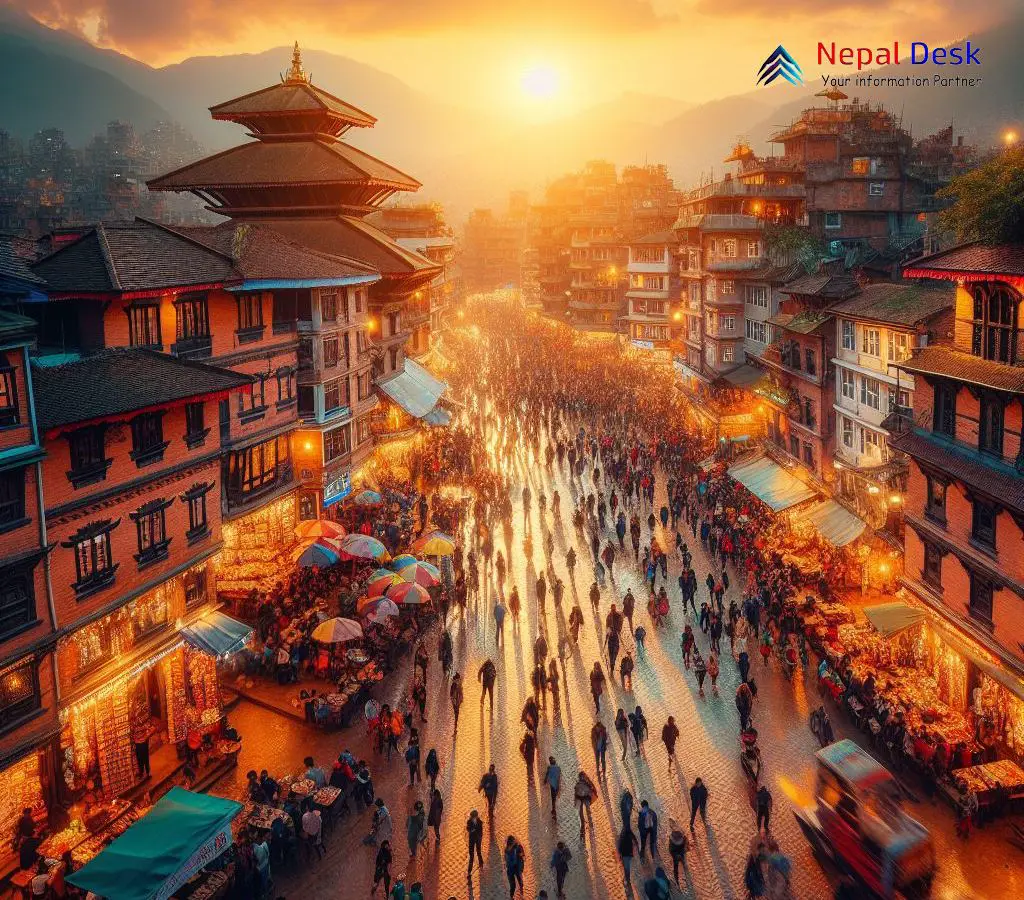Transforming Thamel: Nepal's Ambitious 24-Hour Tourist Hub Plan
Published Date

Published Date
Explore Nepal's ambitious plan to turn Thamel into a 24-hour tourist hub. Discover the economic, cultural, and urban development implications.
⏱ 5 min read
A new action plan aims to develop Thamel into a 24-hour operational tourist hub. Bhabishwor Sharma, president of the Thamel Tourism Development Council (TTDC), spearheads efforts to keep Thamel open day and night. This involves creating a safe and orderly environment for businesses, tourists, and residents.
Previous attempts to facilitate round-the-clock activity in Thamel proved unsuccessful. However, the new proposal outlines specific code of conduct measures through multi-stakeholder collaboration. The guidelines cover responsibilities for homeowners, shopkeepers, visitors, and other groups to enable Thamel to function with dignity within legal frameworks.
The recent installation of CCTV cameras and additional street lighting demonstrate early safety infrastructure upgrades by the TTDC. Meanwhile, a draft "Peace and Safety Management Code of Conduct" has been submitted by the TTDC to the District Security Committee for review. If approved, this code aims to balance vibrant city life with security through zoning and access rules still protecting local families amid hoped-for thriving global destination experiences.
According to Sharma, realizing the 24-hour Thamel vision can significantly benefit tourism growth, and spur investments and employment while generating taxes for economic progression if managed conscientiously. However, success depends on guaranteed state support, particularly around crime prevention. Though overnight activity may develop slowly initially, diverse attractions from shopping to cultural events are planned to expand visitor activity over time.
Through tireless coordination, Sharma believes a responsible, legal, and practical framework is nearing fruition to unlock Thamel’s promise as Nepal’s foremost tourism gateway. This collaborative long-term endeavor seeks to synergistically elevate community safety and market dynamism to uplift Nepal’s overall travel sector performance. If achieved, a new national model could emerge for sustainable urban governance through engaging multiple actors in crafting shared spaces upholding public safety standards.
24/7 Thamel: Opportunities and Challenges:
If successfully implemented, transforming Thamel into a round-the-clock commercial and tourist hub could have significant positive impacts on Nepal’s tourism industry, economy, job creation, urban development, and safety standards.
As Nepal’s premier tourist zone, increasing Thamel’s operating hours would allow businesses to boost revenues while accommodating different international visitor habits and needs at all times. This can multiply tourist spending and length of stays with more amenities available 24/7. One estimate suggests Nepal’s GDP could gain over 5% annually if major tourist areas offered full-scale nighttime economies.
The added economic activity expands employment opportunities from restaurants to hotels, taxis, and entertainment venues, with one projection pointing to 300,000 potential new industry jobs if properly regulated nightlife zones emerge across Nepal.
Moreover, the Thamel pilot could incentivize much-needed infrastructure upgrades leveraging tourism growth to fund wider community improvements in energy, water, transit, and waste systems benefiting local families.
However, critics argue that the sociocultural context differs from Western club scenes. Safety issues around alcohol and drugs coupled with inadequate policing must be addressed before atmospheric night bazaars develop akin to Amsterdam or Bangkok’s vibrant backpacking districts. Mitigating risks of illicit behavior, overcrowding, and noise are paramount so positive gains don’t overwhelm vulnerable groups.
Careful urban planning and resilient security provisioning can balance public order with 24-hour access for global travelers and Nepali youth who increasingly demand vibrant public spaces. If the Thamel experiment succeeds responsibly, a new promising development paradigm for Nepal could catalyze equitable and sustainable growth respecting heritage.
Overall, the nighttime economy concept warrants cautious nurturing to uplift tourism, create jobs, and spur investments across Nepal. However, effects on different communities, management capacities, and social dynamics require ongoing study so opportunities sufficiently outweigh any drawbacks over the long run.
Thamel: Interesting Facts
Here are some interesting facts about Thamel in Nepal in a point-wise format:
- Thamel is located in the heart of Kathmandu Valley and is the epicenter of the tourism industry in Nepal. All major trekking agencies, hotels, restaurants, etc catering to tourists are centered in Thamel.
- Legend has it that the name Thamel came after a 14th-century Malla king, Ranajit Malla, went hunting when his grandson got tired and said "Thamel" which in the Newari language means "I am tired".
- Thamel has been inhabited since around 300 BCE and remnants of old Buddhist monasteries can still be seen amidst the narrow alleys. Pottery pieces dating back 2500 years have been found here.
- Most buildings in Thamel still reflect traditional Newari architecture with intricately carved windows, tiled roofs, hidden courtyards, etc though modern concrete structures are rising.
- Being centrally located, Thamel served as a main trading outpost for Tibetan traders to sell wool, herbs, and foodstuffs brought from Tibet and China.
- The iconic Tridevi Marg in Thamel is the first road where motorcycle rallies were held in the 1950s when bikes were introduced in Nepal.
- Thamel has been the traditional center for mountaineering expeditions to Everest and other Himalayan peaks from the 1950s onwards when trekking opened.
- Scores of music bands and rock groups frequent Thamel's lively nightlife spots, earning it a reputation as Nepal's urban bohemian cultural hub.
- Over the years Thamel has retained its narrow alleys often less than a meter wide which gives it a truly medieval charm and feel, unlike modern mall areas.
- Being highly congested currently, Thamel is often cited as a prime case-study location for urban planners to develop pedestrianized "walking cities" by closing off streets.
